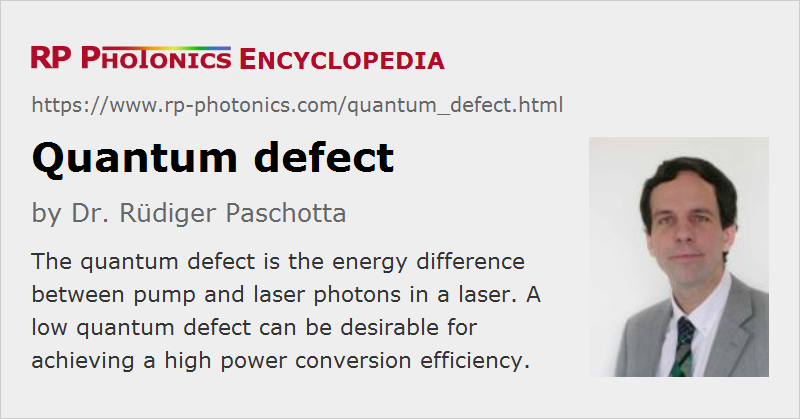Quantum Defect
Definition: energy difference between pump and laser photons
German: Quantendefekt
Category: physical foundations
Formula symbol: q
Units: %
How to cite the article; suggest additional literature
Author: Dr. Rüdiger Paschotta
In most lasers, the laser wavelength is longer than the pump wavelength (exception: upconversion lasers). This means that the energy of the laser photons is smaller than that of the pump photons – there is a so-called Stokes shift. As a consequence, the power efficiency of the laser could not be 100% even if every pump photon could be converted into a laser photon. The quantum defect is defined as the difference in photon energies:

It is also often specified as a percentage of the pump photon energy, effectively using only the parentheses in the equation above. In any case, it sets a lower limit to the loss in the conversion from pump power to laser power, i.e. an upper limit to the power efficiency.
The quantum defect is not related to the quantum efficiency. The latter refers to the average number of output photons per pump photon, rather than to the photon energies.
Some laser crystals (e.g. those doped with ytterbium) have a particularly small quantum defect of only a few percent of the pump photon energy, leading to potentially very high power efficiency. However, a small quantum defect also leads to quasi-three-level behavior of the gain medium, which makes certain aspects of laser design more sophisticated, and may even make it more difficult to achieve a high wall-plug efficiency.
Questions and Comments from Users
Here you can submit questions and comments. As far as they get accepted by the author, they will appear above this paragraph together with the author’s answer. The author will decide on acceptance based on certain criteria. Essentially, the issue must be of sufficiently broad interest.
Please do not enter personal data here; we would otherwise delete it soon. (See also our privacy declaration.) If you wish to receive personal feedback or consultancy from the author, please contact him e.g. via e-mail.
By submitting the information, you give your consent to the potential publication of your inputs on our website according to our rules. (If you later retract your consent, we will delete those inputs.) As your inputs are first reviewed by the author, they may be published with some delay.
See also: quantum efficiency, photons, slope efficiency, Stokes shift
and other articles in the category physical foundations
 |



If you like this page, please share the link with your friends and colleagues, e.g. via social media:
These sharing buttons are implemented in a privacy-friendly way!